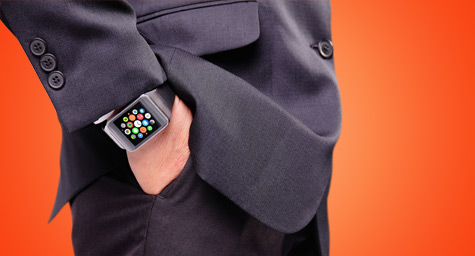A Marketer’s Guide to Wearable Tech
We’ve spent decades imagining how electronic integrations could transform our everyday experiences, with visions ranging from the terrifying (Darth Vader’s iconic life-support suit) to the, er, fanciful (Jane Jetson’s plug-in pageant dress). Now, more than 50 years after Dick Tracy first talked into his wristwatch, the age of wearable technology has arrived.
This is most apparent with recent releases from digital heavyweights—most notably the Apple Watch and Google Glass. However, there are thousands of other wearable tech products already being sold or currently in the works, including smart bras, microchip-filled Polo shirts, and temporary health-tracking tattoos.
This increasing connectivity has implications for all sorts of fields, including marketing. After all, as technology transforms what we wear and how people view their surroundings, the act of engaging consumers will have to evolve.
To answer that, it’s useful to think about the current products as falling into two broad (and somewhat overlapping) buckets: Garments/gear and augmented reality devices.
Here’s what we mean by both of those terms, and the implications of each for marketers:
Garments/Gear
What They Are: These are essentially the things we already wear—watches, shirts, hoodies, socks, wristbands, etc.—with technology integrated into them.
Sounds simple enough, right? Well, it is and it isn’t. Sometimes the integration is pretty clear and is meant to enhance the existing function of the product, such as socks that help you understand your workout.
However, sometimes the tech integration has very little to do with the core function of the garment and instead is a springboard for an entirely new set of uses. For example, the Apple Watch, Pebble Watch, and Android Wear devices all tell time, but their real appeal is the ability to get notifications and complete simple tasks usually done on a smartphone.
Implications for Marketers: The proliferation of garments/gear with technology integrations has a couple of implications for marketers.
First, the world of mobile marketing is sure to evolve significantly. Smartphone screens may seem small compared with the screens of computers, but that is nothing compared with the transition to wearable devices. The screens on the current crop of smart watches are tiny, which means that messaging (push notifications, text coupons, mobile ads, etc.) are going to have to scale down as well if they become popular.
Moreover, a product such as a watch is ever-present, which means that marketers will have to be even more vigilant about the frequency and relevancy of their messaging. It’s bad enough to get pings on your phone from unwanted marketing offers; it’s even worse when those buzzes are constantly occurring directly on your wrist.
Beyond that, the rise of digital garments is part of a deeper trend that marketers need to be mindful of: the increased convergence of product and messaging.
A prime example of this is Nike+. On one level, the product is essentially a watch/wristband/app fitness tracker. However, it is also much more. Nike+ serves as a motivator to buy shoes (since a linked sensor is integrated into some Nike footwear), a community builder (where consumers can track workouts/share achievements), and even a tech platform (with mobile OS and Xbox integrations).
Put another way, Nike+ showcases that savvy companies can make wearable tech part of a larger platform that integrates both product functionality and marketing messaging.
Augmented Reality Devices
What They Are: Many of the wearable devices already covered are essentially seeking to extend digital functionality to a particular thing (a watch, a pair of socks, etc.). However, another set of products is trying to bring the digital world to everything.
The most prominent of these is Google Glass. On one hand, you could argue that Glass is simply making eyeglasses better, but that’s deeply downplaying the company’s (ahem) vision. The grand plan for Glass is that it is meant to give consumers Terminator-esque access to data, where the wealth of information now available in bits and bytes can be tapped into instantly in real-life situations with minimal effort.
Implications for Marketers: Because it is trying to invent a completely new way for humans to interact with their environments, Google’s wearable tech is inherently a more risky bet. The Apple Watch may not be a huge hit, but the form is familiar enough and the functions simple enough that it’ll probably appeal to a decent number of consumers.
Glass could very well fail. However, Google has deep pockets and isn’t alone in the space (Facebook’s virtual reality headset, Oculus Rift, could easily cross the line into wearable tech). Ultimately, the product (or one like it) could succeed, and that would change everything for marketers.
If augmented reality does become real, every marketing channel will be transformed. Does that sound dramatic? Well, imagine a world where a consumer can look at a billboard and blink to buy the service advertised; hear a bit of music and shake their head to buy the song; walk into a store and purchase the same product for less online by simply staring.
These scenarios, of course, aren’t a reality yet. However, if you look at what people are already doing with Google Glass they don’t seem nearly as farfetched as they once did. The distant future is suddenly upon us, and every marketer should be prepared.
Keep up with the latest developments in wearable technology. Contact MDG today at 561-338-7797 or visit www.mdgsolutions.com.
MDG is a full-service advertising agency and one of Florida’s top branding firms. With offices in Boca Raton and New York City, MDG’s core capabilities include branding, logo design, print advertising, digital marketing, mobile marketing, email marketing, media planning and buying, TV and radio, outdoor advertising, newspaper, video marketing, Web design and development, content marketing, mobile marketing, social media marketing, and SEO. To discover the latest trends in branding and advertising, contact MDG today at 561-338-7797.

